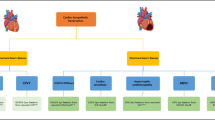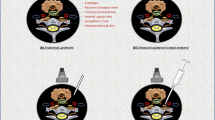Introduction
Cardiac sympathetic denervation (CSD) is an effective therapy for selected patients with drug refractory ventricular arrhythmias (VA). Data about the role of CSD in patients with structural heart disease and VAs are sparse. We herein present our experience of CSD in patients with nonischemic cardiomyopathy and VAs despite prior ablation procedure and/or antiarrhythmic drug (AAD) therapy.
Methods
A total of ten patients (mean age 61.6 ± 19.6, mean LVEF 29.5 ± 12.1%) with nonischemic dilated cardiomyopathy (NICM) (n = 9) and hypertrophic cardiomyopathy (HCM) (n = 1) underwent CSD (left sided in six and bilateral in four patients) due to refractory VA despite multiple AADs (mean number of AADs was 1.6 ± 0.7) and prior VT ablation (mean number of procedures per patient was 1.5 ± 1.3).
Results
Mean follow-up was 10.1 ± 6.9 months. The median number of VA and ICD shocks decreased significantly from 9.0 and 2.5 episodes 6 months prior to CSD to 0 and 0 episodes within 6 months after CSD (p = 0.012 and p = 0.011). Five patients remained free from sustained VA recurrences. Two patients experienced single ICD shock due to a polymorphic VT (triggered by severe hypokalemia in one patient) and one patient a single shock due to monomorphic VT. One patient had five episodes of slow VT under amiodarone therapy (three of them terminated by antitachycardia pacing) and underwent endo- epicardial re-ablation. Two patients died 1 month after CSD. One of them due to electrical storm and cardiogenic shock and the second one due to refractory cardiogenic shock, without recurrence of VAs though. No major complications of CSD occurred. No patient suffered from Horner syndrome.
Conclusion
In this study, CSD was effective for treatment of VAs in patients with structural heart disease refractory to antiarrhythmic drugs and catheter ablation. Further larger studies are required to confirm these findings.
Graphic abstract




Similar content being viewed by others
References
Yalin K, Golcuk E, Buyukbayrak H, Yilmaz R, Arslan M, Dursun M, Bilge AK, Adalet K (2014) Infarct characteristics by CMR identifies substrate for monomorphic VT in post-MI patients with relatively preserved systolic function and ns-VT. Pacing Clin Electrophysiol 37:447–453
Kuck KH, Tilz RR, Deneke T, Hoffmann BA, Ventura R, Hansen PS, Zarse M, Hohnloser SH, Kautzner J, Willems S, SMS Investigators (2017) Impact of substrate modification by catheter ablation on implantable cardioverter-defibrillator interventions in patients with unstable ventricular arrhythmias and coronary artery disease: results from the multicenter randomized controlled SMS (substrate modification study). Circ Arrhythm Electrophysiol. 10(3):e004422
Reddy VY, Neuzil P, Taborsky M et al (2003) Short-term results of substrate mapping and radiofrequency ablation of ischemic ventricular tachycardia using a saline-irrigated catheter. J Am Coll Cardiol 41:2228–2236
Di Biase L, Santangeli P, Burkhardt DJ et al (2012) Endo-epicardial homogenization of the scar versus limited substrate ablation for the treatment of electrical storms in patients with ischemic cardiomyopathy. J Am Coll Cardiol 60:132–141
Jaïs P, Maury P, Khairy P et al (2012) Elimination of local abnormal ventricular activities: a new end point for substrate modification in patients with scar-related ventricular tachycardia. Circulation 125:2184–2196
Marchlinski FE, Callans DJ, Gottlieb CD et al (2000) Linear ablation lesions for control of unmappable ventricular tachycardia in patients with ischemic and nonischemic cardiomyopathy. Circulation 101:1288–1296
Tilz RR, Makimoto H, Lin T et al (2014) Electrical isolation of a substrate after myocardial infarction: a novel ablation strategy for unmappable ventricular tachycardias–feasibility and clinical outcome. Europace 16:1040–1052
Vergara P, Trevisi N, Ricco A et al (2012) Late potentials abolition as an additional technique for reduction of arrhythmia recurrence in scar related ventricular tachycardia ablation. J Cardiovasc Electrophysiol 23:621–627
Yalin K, Golcuk E, Bilge AK, Aksu T, Buyukbayrak H, Tiryakioglu SK, Emet S, Adalet K (2015) Combined analysis of unipolar and bipolar voltage mapping identifies recurrences after unmappable scar-related ventricular tachycardia ablation. Europace 17(10):1580–1586
Vaseghi M, Shivkumar K (2008) The role of the autonomic nervous system in sudden cardiac death. Prog Cardiovasc Dis 50:404–419
Vaseghi M, Zhou W, Shi J, Ajijola OA, Hadaya J, Shivkumar K, Mahajan A (2012) Sympathetic innervation of the anterior left ventricular wall by the right and left stellate ganglia. Heart Rhythm 9(8):1303–1309
Schwartz PJ, Snebold NG, Brown AM (1976) Effects of unilateral cardiac sympathetic denervation on the ventricular fibrillation threshold. Am J Cardiol 37:1034–1040
Collura CA, Johnson JN, Moir C, Ackerman MJ (2009) Left cardiac sympathetic denervation for the treatment of long QT syndrome and catecholaminergic polymorphic ventricular tachycardia using video-assisted thoracic surgery. Heart Rhythm 6:752–759
Bhandari AK, Scheinman MM, Morady F, Svinarich J, Mason J, Winkle R (1984) Efficacy of left cardiac sympathectomy in the treatment of patients with the long QT syndrome. Circulation 70:1018–1023
Olde Nordkamp LRA, Driessen AHG, Odero A, Blom NA, Koolbergen DR, Schwartz PJ, Wilde A (2014) Left cardiac sympathetic denervation in the Netherlands for the treatment of inherited arrhythmia syndromes. Neth Heart J Mon J Neth Soc Cardiol Neth 22:160–166
Wilde AAM, Bhuiyan ZA, Crotti L, Facchini M, De Ferrari GM, Paul T, Ferrandi C, Koolbergen DR, Odero A, Schwartz PJ (2008) Left cardiac sympathetic denervation for catecholaminergic polymorphic ventricular tachycardia. N Engl J Med 358:2024–2029
Kuck KH, Schaumann A, Eckardt L et al (2010) Catheter ablation of stable ventricular tachycardia before defibrillator implantation in patients with coronary heart disease (VTACH): a multicentre randomised controlled trial. Lancet 375:31–40
Sapp JL, Wells GA, Parkash R et al (2016) Ventricular tachycardia ablation versus escalation of antiarrhythmic drugs. N Engl J Med 375:111–121
Ben-David J, Zipes DP (1988) Differential response to right and left ansae subclaviae stimulation of early afterdepolarizations and ventricular tachycardia induced by cesium in dogs. Circulation 78:1241–1250
Opthof T, Coronel R, Vermeulen JT, Verberne HJ, van Capelle FJ, Janse MJ (1993) Dispersion of refractoriness in normal and ischaemic canine ventricle: effects of sympathetic stimulation. Cardiovasc Res 27:1954–1960
Priori SG, Mantica M, Schwartz PJ (1988) Delayed afterdepolarizations elicited in vivo by left stellate ganglion stimulation. Circulation 78:178–185
Cao JM, Fishbein MC, Han JB, Lai WW, Wu TJ, Czer L, Wolf PL, Denton TA, Shintaku IP, Chen PS, Chen LS (2000) Relationship between regional cardiac hyperinnervation and ventricular arrhythmia. Circulation 101:1960–1969
Benedict CR, Johnstone DE, Weiner DH, Bourassa MG, Bittner V, Kay R, Kirlin P, Greenberg B, Kohn RM, Nicklas JM (1994) Relation of neurohumoral activation to clinical variables and degree of ventricular dysfunction: a report from the Registry of Studies of Left Ventricular Dysfunction. SOLVD Investigators. J Am Coll Cardiol 23:1410–1420
Zhou W, Chen J (2013) I -123 metaiodobenzylguanidine imaging for predicting ventricular arrhythmia in heart failure patients. J Biomed Res 27:460–466
Abdulghani M, Duell J, Smith M et al (2015) Global and regional myocardial innervation before and after ablation of drug-refractory ventricular tachycardia assessed with 123I- MIBG. J Nucl Med 56:52S–58S
Klein T, Abdulghani M, Smith M, Huang R, Asoglu R, Remo BF, Turgeman A, Mesubi O, Sidhu S, Synowski S, Saliaris A, See V, Shorofsky S, Chen W, Dilsizian V, Dickfeld T (2015) Three-dimensional 123I-meta-iodobenzylguanidine cardiac innervation maps to assess substrate and successful ablation sites for ventricular tachycardia: feasibility study for a novel paradigm of innervation imaging. Circ Arrhythm Electrophysiol 8(3):583–591
Vaseghi M, Lellouche N, Ritter H, Fonarow GC, Patel JK, Moriguchi J, Fishbein MC, Kobashigawa JA, Shivkumar K (2009) Mode and mechanisms of death after orthotopic heart transplantation. Heart Rhythm 6:503–509
Bourke T, Vaseghi M, Michowitz Y, Sankhla V, Shah M, Swapna N, Boyle NG, Mahajan A, Narasimhan C, Lokhandwala Y, Shivkumar K (2010) Neuraxial modulation for refractory ventricular arrhythmias: value of thoracic epidural anesthesia and surgical left cardiac sympathetic denervation. Circulation 121(21):2255–2262
Vaseghi M, Gima J, Kanaan C et al (2014) Cardiac sympathetic denervation in patients with refractory ventricular arrhythmias or electrical storm: intermediate and long-term follow-up. Heart Rhythm 11:360–366
Vaseghi M, Barwad P, Malavassi Corrales FJ et al (2017) Cardiac sympathetic denervation for re- fractory ventricular arrhythmias. J Am Coll Cardiol 69:3070–3080
Richardson T, Lugo R, Saavedra P, Crossley G, Clair W, Shen S, Estrada JC, Montgomery J, Shoemaker MB, Ellis C, Michaud GF, Lambright E, Kanagasundram AN (2018) Cardiac sympathectomy for the management of ventricular arrhythmias refractory to catheter ablation. Heart Rhythm 15(1):56–62
Author information
Authors and Affiliations
Corresponding authors
Rights and permissions
About this article
Cite this article
Yalin, K., Liosis, S., Palade, E. et al. Cardiac sympathetic denervation in patients with nonischemic cardiomyopathy and refractory ventricular arrhythmias: a single-center experience. Clin Res Cardiol 110, 21–28 (2021). https://doi.org/10.1007/s00392-020-01643-8
Received:
Accepted:
Published:
Issue Date:
DOI: https://doi.org/10.1007/s00392-020-01643-8




